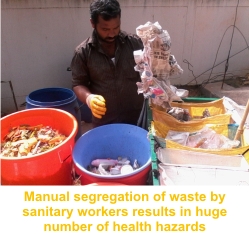|
Automated Waste Segregation
System for M unicipal solid waste management is one of the most difficult challenges faced in India. Although technologies are available for proper processing of different streams of waste, the lack of proper segregation results in less efficient processing leading to a creation of huge portion of inerts which end up in the landfills and dumpyards.Several attempts have been made to incorporate the practice of manual source segregation among citizens but has failed in the long run due to several reasons. Automated waste sorting technology is a base of the pyramid solution, which is several times efficient than manual sorting and helps create proper waste streams for further treatment and utilisation. Proper segregation and streamlining of waste can reduce the burden at dumpsites and landfills tremendously. Although the concept of automation popped up in the developed countries during the early 1980s, lack of proper technology lead to its failure and again the authorities had to focus on citizens to do source segregation. The advancement of Infrared Technology and Artificial Intelligence in the recent past has led to the new generation of ‘Automated Waste Sorting Technology’ (AWST) where sensor based identification of different waste streams is utilised to segregate the waste.
The technology was initially developed for segregation of Construction & Demolition Waste (C&D Waste) but later modified for segregation of waste into several other categories. Although the technology is in its infant stages, it brings hope of a better waste management system. Though implemented in the developed world, its scope is much more in developing countries like India, taking into consideration the major urbanisation which is considered to happen in the very near future. In addition to the municipal solid waste application of the technology, its application in C&D waste management is much more critical in India taking into account that more than 70% of the infrastructure requirements in India are yet to be built by 2030. The technology also helps segregation of critical waste elements including hazardous waste and electronic waste from the mainstream without manual sorting which all the more makes the segregation more efficient. In addition, the sorted waste streams also gives more business opportunities using recovered materials and helps in resource savings. The technology bears multiple fruits as it allows segregation and collection of several waste fractions together as it saves time, reduces labor intensity and helps save valuable resources. Above all, it reduces health hazards to the sanitary workers who manually handle the waste during segregation, usually without proper personal protective equipments. The use of similar technologies is now very relevant in India especially after the recommendations in the latest SWM Waste Management Rules 2016 and C&D Waste Management Rules 2016 which state that the waste mandatorily needs to be sorted before treatment. The timelines mentioned in the rules also urge the Urban Local Bodies in India to utilise different kind of adoptive and absorptive innovations like the AWST in waste management that could become a boon. More research and development needs to be done to the technology in order to customise it according to the needs of the Indian waste sector which needs investment in terms of resources by different stakeholders. ■Achu R Sekhar References: https://waste-management-world.com/a/rise-of-the-machines-robot-recycling http://sciencenordic.com/machines-are-better-people-sorting-household-trash https://waste-management-world.com/a/innovative-sorting-an-essential-for-economic-improvements-in-waste-handling http://devalt.org/newsletter/Aug15/of_3.htm http://www.theatlantic.com/international/archive/2014/06/70-percent-of-india-has-yet-to-be-built/373656/ http://timesofindia.indiatimes.com/city/nagpur/Streamline-solid-waste-reduce-burden-on-dump-site-Experts/articleshow/52284880.cms http://www.moef.nic.in/content/so-1357e-08-04-2016-solid-waste-management-rules-2016 http://www.moef.gov.in/sites/default/files/C%20&D%20rules%202016.pdf |
 Unlike other automated processes where the machines
follow a definite set of algorithm to repeat a specific number of steps
in a sequential manner, segregation of MSW is a much more complex
process as the waste composition and characteristics in each batch
differs. AWST uses a combination of Infrared sensors or X-ray scanners
along with application of Artificial Intelligence to segregate the waste
depending upon their density, light absorption factor and several other
factors. The materials moving over a conveyer belt are scanned for their
physical and chemical properties and then separated using a jet of air,
magnets robotic arms or combination of these methods which are
controlled by computers.
Unlike other automated processes where the machines
follow a definite set of algorithm to repeat a specific number of steps
in a sequential manner, segregation of MSW is a much more complex
process as the waste composition and characteristics in each batch
differs. AWST uses a combination of Infrared sensors or X-ray scanners
along with application of Artificial Intelligence to segregate the waste
depending upon their density, light absorption factor and several other
factors. The materials moving over a conveyer belt are scanned for their
physical and chemical properties and then separated using a jet of air,
magnets robotic arms or combination of these methods which are
controlled by computers.